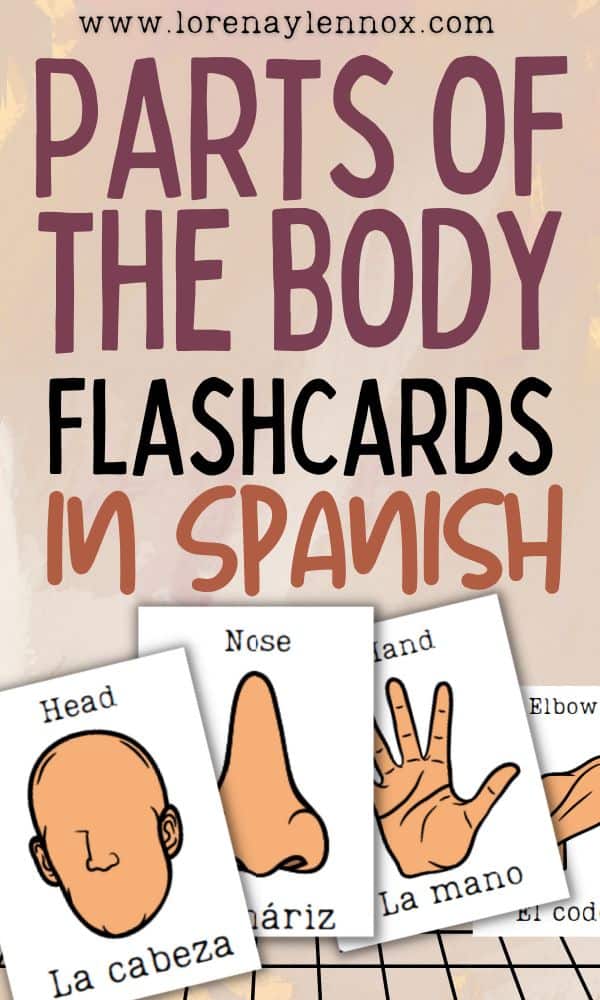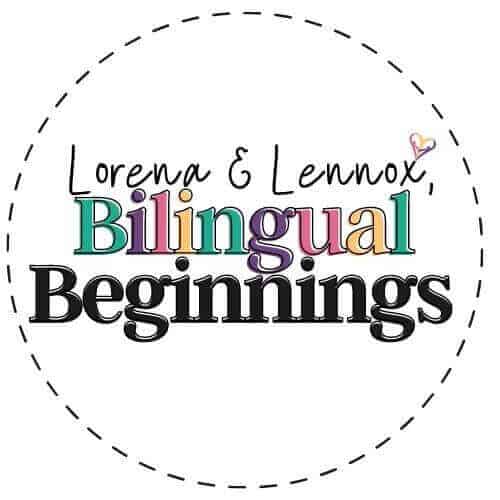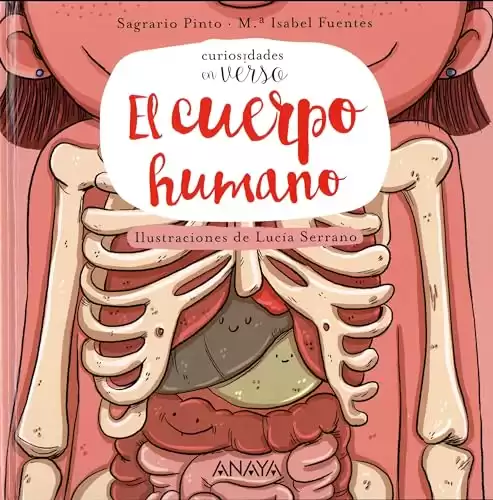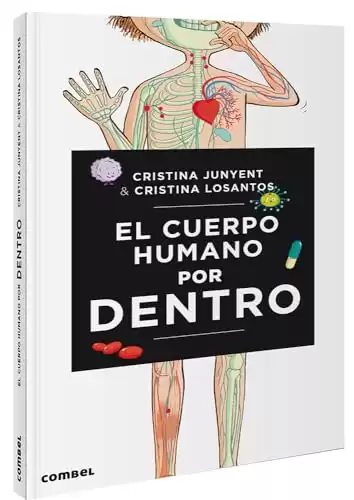Are your students learning body parts in Spanish? If so, this post has you covered with vocabulary lists, body part resources, printable worksheets and more!
Learning body parts in Spanish is a fascinating subject for kids, especially to learn about it in a foreign language!
That’s why today, we will go over important parts of the body in Spanish. I will break the body parts into different categories. Learn them all at once, or break them up into different lessons, you decide!
At the end of this post I will share a few fun and free learning resources you can use to aid your students in memorizing and learning the body parts in Spanish.
- Learning Body Parts in Spanish
- The Main Parts of the Body in Spanish
- learning body parts in Spanish: the Head
- Learning Body parts in Spanish: Arms
- learning Body parts in Spanish: Legs and Feet
- learning Body parts in Spanish: Organs & Bones
- Books about body parts in Spanish
- YouTube Videos about Body Parts in Spanish
- free body parts in Spanish resources for kids
- How can you get your free body parts in Spanish flashcards & Worksheet?
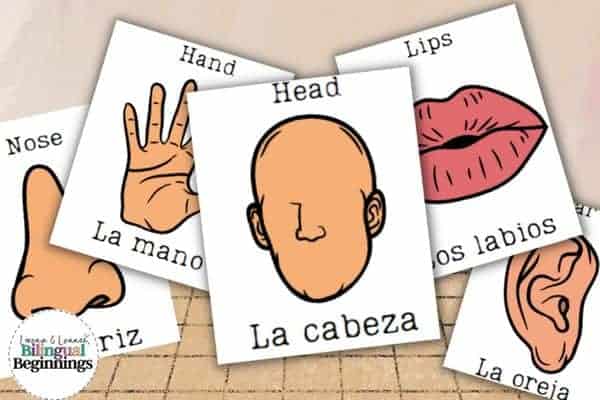
Learning Body Parts in Spanish
Instead of diving into a list of all the parts of the body in Spanish, I decided to separate the parts into different categories to make learning the new vocabulary easier.
For starters, I will mention common body parts. On this list, you can find commonly used body parts that one might talk about on a daily, or weekly basis, such as hands, or feet, and even knees.
Then afterwards, I will share a list of head body parts vocabulary, arm vocabulary, leg vocabulary and organs. Next, I will include relevant vocabulary about illness & injuries and verbs associated with talking about the parts of the body in Spanish.
Feel free to share my graphics on Pinterest for reference points!
The Main Parts of the Body in Spanish

El cuerpo
Body
La cabeza
Head
El cuello
Neck
El pecho
Chest/ breast
El brazo
Arm
La mano
Hand
*Ojo: Even though the word mano ends with an O, mano is a feminine word: la mano, las manos.
Example sentences:
Debes de ir a lavarte las manos
You should go wash your hands.
Tu mano izquierda es más grande que tu mano derecha.
Your left hand is bigger than your right.
El estómago
Stomach
El vientre
Abdomen
Las costillas
Ribs
El torso
Torso
El seno
Breast
La espalda
Back
Las nalgas
Buttocks
La cintura
Waist
Las caderas
Hips
Las piernas
Legs
Las rodillas
Knees
Los pies
Feet
A fun way to start talking about the body parts in Spanish is by talking about how many of each body part we have. For example:
¿Cuántos pies tienes?
How many feet do you have?
¿Tienes una cabeza o dos?
Do you have one head, or two?
This will get the kids (especially the younger ones) giggling away!
I used to do this all the time with my son when he was a toddler. It is great vocabulary practice as well as counting practice, too.
Related: Spanish Numbers 1-30: Free Printable Flashcards for Kids
learning body parts in Spanish: the Head

Above we learned that head in Spanish is la cabeza. Now, let’s learn about things that can be found on our cabeza!
La cabeza
Head
La cara
Face
El pelo or El cabello
Hair
La frente
Forehead
Las cejas
Eyebrows
Las orejas
Ears
El oído
The inside of the ear
Las mejillas
Cheeks
La nariz
Nose
La garganta
Throat
La barbilla
Chin
La mandíbula
Jaw
Los ojos
Eyes
Las pestañas
Eyelashes
La boca
Mouth
Los labios
Lips
La lengua
Tongue
Los dientes
Teeth
El cráneo
Skull
Learning Body parts in Spanish: Arms
Now let’s move on to the arms and work our way down to the fingers!

El brazo
Arm
El hombro
Shoulder
El antebrazo
Forearm
El codo
Elbow
La mano
Hand
La muñeca
Wrist
La palma
Palm
Las uñas
Nails
El dedo
Finger
El pulgar
Thumb
El índice
Pointer finger
El dedo del medio
Middle finger
El dedo anular
Ring finger
El meñique
Pinky finger
learning Body parts in Spanish: Legs and Feet
Our last category before we make our way into the organs is legs and feet. Here goes.

La pierna
Leg
El muslo
Thigh
La rodilla
Knee
La pantorrilla
Shin
El tobillo
Ankle
El pie
Foot
El talón
Heel
El dedo de pie/ los dedos del pie
Toe/s
learning Body parts in Spanish: Organs & Bones
So far we have learned main body parts, head and face vocabulary and arms and leg vocabulary in Spanish. Now let’s learn a little bit about what’s on the inside of our body in Spanish.
Below you can find a small list of internal organs and bones vocabulary in Spanish.
Los órganos
Organs
El corazón
Heart
El estómago
Stomach
Los pulmones
Lungs
El hígado
Liver
Los riñones
Kidneys
Los intestinos
Intestines
La espina
Spine
El hueso
Bone
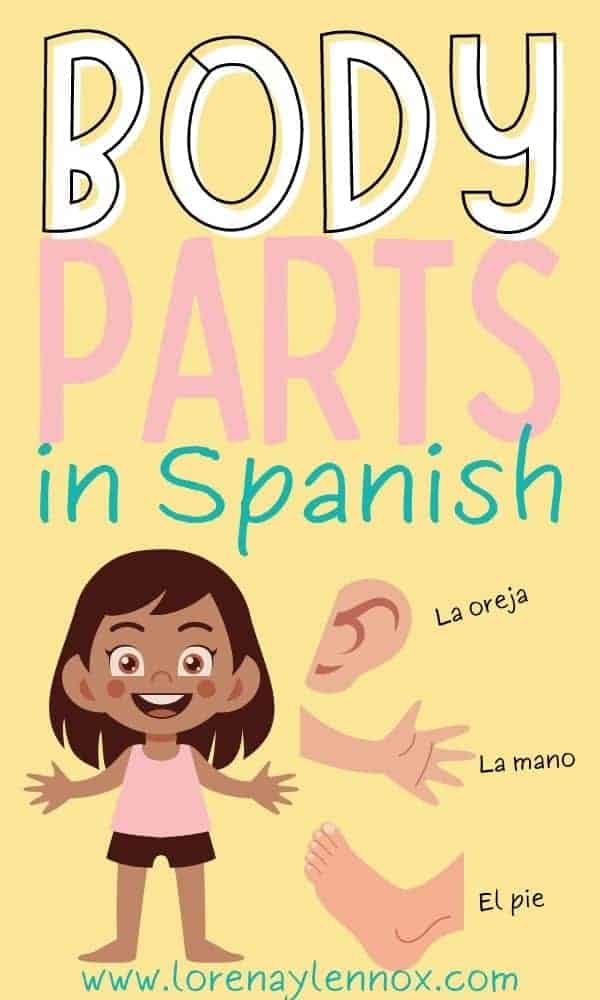
Illness, Injuries & Symptoms Vocabulary
What are some ways to incorporate talking about body parts in Spanish in the classroom? Open up dialogue using some of the following illness, injuries and symptoms vocabulary.
Then use some of the following questions and phases to your students encouraging them to practice the new Spanish body parts vocabulary to tell you where, when or why these things happened.
Un dolor de … oído/garganta/cabeza/estómago/espalda
An ear/throat/head/stomach/backache
El asma
Asthma
La tos
Cough
Un resfriado
A cold
La Varicela
Chicken pox
Los piojos
Lice
Un esguince de muñeca/tobillo
Sprained wrist/ankle
Un pie inflamado/ una mano inflamada
A swollen foot/ A swollen hand
El gripe
The flu
Una fiebre
Fever
El artritis
Arthritis
Un corte
A cut
Una ampolla
A blister
Un sarpullido
Rash
Una quemadura del sol
Sunburn
Una picadura de abeja
A bee sting
Una hemorragia nasal
A bloody nose
Una contusion
Bruise
Hurting and Healing Verbs
Tener dolor
To be in pain
Estar inconsciente
To be unconscious
Sangrar
To bleed
Quebrar/romper un hueso
To break a bone
Atragantarse
To choke
Cortarse
To cut oneself
Ahogarse
To drown
Tener una reacción alérgica
To have an allergic reaction
Tener un ataque cardiaco
To have a heart attack
Caerse
To fall
Toser
To Cough
Estornudar
To sneeze
Vomitar
To throw up
Tomarse la temperatura
To take one’s temperature
Llamar al doctor
To call the doctor
Hacer una cita
To make an appointment
Descansar
To rest
Tomar una pastilla
To take a pill
Tomar/ beber líquidos
To drink liquids
Sentirse mejor
To feel better
Grammar rules when describing body parts in Spanish
It is helpful to know the parts of the body vocabulary in Spanish, but it is also important to know how to use them in phrases, too.
Below I will drop a list of phrases that you can use, but first, I want to mention a few important grammar rules when talking about body parts in Spanish.
Grammar rule number one, always use definite articles when talking about the body parts in Spanish. Definite articles are el and la for singular words, and los and las for plural words.
El dedo, los dedos
The finger, the fingers
Even if you are talking about two body parts in one sentence, make sure to always bring the definite article along.
La rodilla y la cadera.
The knee and hip.
La muñeca, las muñecas.
The wrist, the wrists.
Furthermore, when talking about body parts in Spanish, possessive adjectives are not used to describe the body part unless it is not clear whose body part is being talked about.
Me cepillo los dientes
I brush my teeth.
Notice that you still use the definite article in Spanish and not the possessive adjective. The ownership is expressed by the reflexive pronoun me.
Body parts Phrases in Spanish
Me lavo las manos.
I wash my hands.
Tu te cepillas los dientes.
You brush your teeth.
Ella se peina el pelo.
She brushes her hair.
Me corté el dedo
I cut my finger
¡Abre los ojos!
Open your eyes
Me duele la cabeza
My head hurts
¿Te duele la garganta?
Does your throat hurt?
Ella se rompió el brazo.
She broke her arm.
Me siento mejor de la rodilla.
My knee feels a lot better.
Books about body parts in Spanish
Now that we know a whole bunch of new body part vocabulary in Spanish, let’s pair them with some picture books in Spanish about el cuerpo humano. Below are a few recommendations.
By: DK
This is the perfect bilingual board book for your baby or toddler ages 0-2 to learn about the body in Spanish.
By: Sagrario Pinto
Learn about the curiosities of the body through simple verses and rhyme with this book perfect for children ages 3-12.
El cuerpo humano por fuera
By: Maria Cristina Junyent
YouTube Videos about Body Parts in Spanish
Furthermore, we can pair the new body parts in Spanish vocabulary with the following information YouTube videos.
The first video is my favorite! It is an interactive song in Spanish for kids that will get them up and dancing and using different body parts vocabulary.
It’s called “El marinero baila” by the YouTube Channel El Reino Infantil It is so catchy that young learners will be singing the different parts of the body in Spanish in no time!
Related: YouTube Channels in Spanish for Kids
Below is an informative video that explains the different parts of the body in Spanish.
Next is a fun, rock-type song by Rockalingua that mention different parts of the body in Spanish.
free body parts in Spanish resources for kids
I know you have been waiting the entire post for this, but you finally made it to the free body parts resources in Spanish.
What resources come in these free activities?
For starters, once you subscribe (instructions on how to get yours further down), you will have access to a fill in the body parts worksheet.

It comes with three pages. One in color, one in black and white and the last page is an answer key.
Related: 25 + Body Parts Activities for Toddlers & Preschoolers
You will also receive 24 bilingual body parts in vocabulary flashcards!

How can you get your free body parts in Spanish flashcards & Worksheet?
If you are already a subscriber, your digital download will arrive in your inbox shortly.
If you are new to Lorena & Lennox, Bilingual Beginnings, or have been shy to subscribe, you can do so at the end of this post by entering your email address. Not only will you receive exclusive access to these coloring pages,, but other seasonal and holiday-related activities in Spanish for kids!
Once you subscribe, please make sure to check your inbox to confirm your subscription first.
If you do not see a confirmation email, check your junk or spam folder. It sometimes accidentally lands there. After you confirm your subscription, you will receive a welcome email with a passcode to enter the free printable library.
More Spanish Flashcards for kids
- 22 Space Flashcards in Spanish for Kids
- Sports in Spanish: Vocabulary, conversation Starters and Free Printable Flashcards
- Spanish Numbers 1-30: Free Printable Flashcards for Kids
- 23 Transportation Vocabulary Flashcards in Spanish for Kids
- Family Words in Spanish Free Printable Bilingual Flashcards
- 24 Bilingual Spanish/English Emotions Flashcards
- 24 Beach Words in Spanish to Prepare for La Playa This Summer! [Free Printable Flashcards]
Alright, now that you know a few fun ways to use your body parts flashcard in Spanish flashcards, head to the box directly below and enter in your e-mail. Don’t forget to confirm. If you do not see a confirmation email, check your spam folder, sometimes they like to land there.
Well I hope you learned some new words about the human body parts in Spanish after today’s post! I hope you enjoy your free printables!
Additional Spanish Resources
- Naranja vs Anaranjado: What’s the Difference?
- Planets in Spanish: A Complete Guide + Learning Activities for Kids
